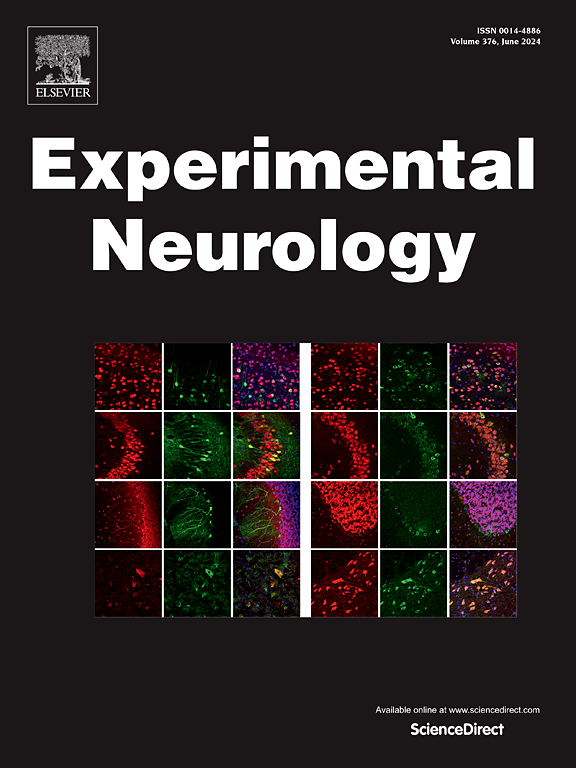Dendritic morphological development of traumatic brain injury-induced new neurons in the dentate gyrus is important for post-injury cognitive recovery and is regulated by Notch1
IF 4.6
2区 医学
Q1 NEUROSCIENCES
引用次数: 0
Abstract
Traumatic brain injury (TBI) is a prevalent problem with survivors suffering from chronic cognitive impairments. Following TBI there is a series of neuropathological changes including neurogenesis. It is well established that neurogenesis in the dentate gyrus (DG) of the hippocampus is important for hippocampal dependent learning and memory functions. Following TBI, injury-enhanced hippocampal neurogenesis is believed to contribute to post-injury cognitive recovery. Behavioral function is connected to synaptic plasticity and neuronal dendritic branching is critical for successful synapse formation. To ascertain the functional contribution of injury-induced DG new neurons in post-TBI cognitive recovery, it is necessary to study their dendritic morphological development and the molecular mechanisms controlling this process. Utilizing transgenic mice with tamoxifen-induced GFP expression and Notch1 knock-out in nestin+ neural stem cells, this study examined dendritic morphology, the role of Notch1 in regulating dendritic complexity of injury-induced DG new neurons, and their association to post-TBI cognitive recovery. We found that at 8 weeks after a moderate TBI, injury-induced DG new neurons in the injured control mice displayed a similar dendritic morphology as the cells in non-injured mice accompanied with cognitive recovery. In comparison, in Notch1 conditional knock-out mice, DG new neurons in the injured mice had a significant reduction in dendritic morphological development including dendritic arbors, volume span, and number of branches in comparison to the cells in non-injured mice concomitant with persistent cognitive dysfunction. The results of this study confirm the importance of post-injury generated new neurons in cognitive recovery following TBI and the role of Notch1 in regulating their maturation process.
创伤性脑损伤诱导的齿状回新神经元的树突形态发育对伤后认知能力的恢复非常重要,并受 Notch1 的调控。
创伤性脑损伤(TBI)是一个普遍存在的问题,幸存者患有慢性认知障碍。创伤性脑损伤后会出现一系列神经病理学变化,包括神经发生。海马齿状回(DG)的神经发生对海马依赖性学习和记忆功能非常重要,这一点已得到公认。创伤性脑损伤后,损伤增强的海马神经发生被认为有助于损伤后认知能力的恢复。行为功能与突触可塑性有关,而神经元树突分支对于突触的成功形成至关重要。为了确定损伤诱导的 DG 新神经元在创伤后认知恢复中的功能贡献,有必要研究它们的树突形态发育和控制这一过程的分子机制。本研究利用他莫昔芬诱导的GFP表达和Notch1敲除nestin+神经干细胞的转基因小鼠,研究了树突形态、Notch1在调节损伤诱导的DG新神经元树突复杂性中的作用以及它们与创伤后认知恢复的关系。我们发现,在中度创伤性脑损伤后 8 周,受伤对照组小鼠的损伤诱导 DG 新神经元显示出与非损伤小鼠细胞相似的树突形态,并伴有认知恢复。相比之下,在Notch1条件性敲除小鼠中,受伤小鼠的DG新生神经元的树突形态发育(包括树突轴、体积跨度和分支数量)与未受伤小鼠的细胞相比显著下降,同时伴有持续的认知功能障碍。这项研究结果证实了损伤后生成的新神经元在创伤性脑损伤后认知功能恢复中的重要性,以及 Notch1 在调节其成熟过程中的作用。
本文章由计算机程序翻译,如有差异,请以英文原文为准。
求助全文
约1分钟内获得全文
求助全文
来源期刊

Experimental Neurology
医学-神经科学
CiteScore
10.10
自引率
3.80%
发文量
258
审稿时长
42 days
期刊介绍:
Experimental Neurology, a Journal of Neuroscience Research, publishes original research in neuroscience with a particular emphasis on novel findings in neural development, regeneration, plasticity and transplantation. The journal has focused on research concerning basic mechanisms underlying neurological disorders.
 求助内容:
求助内容: 应助结果提醒方式:
应助结果提醒方式:


